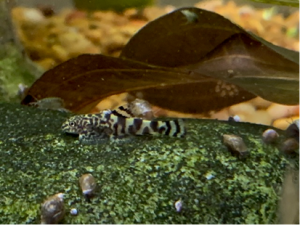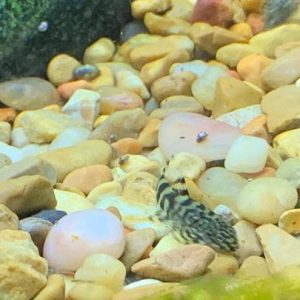
Hillstream loach – Balitorid, scientific name: Sewellia lineolate
Hillstream loach – Balitorid, scientific name: Sewellia lineolate
submitted by Char Thorton (mad fish diva)
This post will focus on a particular genus of Hillstream loach – Balitorid, scientific name: Sewellia Lineolata (Valenciennes, 1849) Order: Cypriniformes Family: Gastromyzontidae. A freshwater, subtropical fish which is quite unique and fairly rare in the hobby. This fish came into my purview after viewing a video of a Hillstream tank set-up by a very popular aquatic expert and fish keeping YouTuber Rachel O’leary. (msjinkzd.com)
My background: I began keeping fresh water fish at the age of about 12 when I purchased a single pregnant molly. My first tank was a 10-gallon meta-frame aquarium with a slate bottom and box filter with fiberus filter media and charcoal. I’ve been keeping fish on an off for about 40 years and have been amazed at the growth and development of the hobby and the progress as it relates to the introduction and benefits of planted aquariums. I currently have 9 aquariums with close to a total of 240 gallons of water, hardscape and fish. The live-stock consist of: Ameca Splendens- butterfly goodeid (CARES), Pepper Cory, Golden Pearl Scale and Koi Angels, Dwarf Rainbows – Psedumogil Signifiers, Guppies, Golden and White Cloud Mountain Minnows, Platys, Dwarf Indian Puffers, Wild Type Tiger shrimp, Amano shrimp and several mystery and pond snails, and of course approximately 28, of the topic of this post Hillstream Loach, Sewellia Lineolata.
There is much to be discovered about these beautiful creatures and this particular post will examine varied information and research, and provide information on my personal experience keeping and breeding these beautiful fish for almost two years.
Hillstream Loach – Balitorid, scientific Species: Sewellia lineolate
Origin: South, Southeast and East Asia
During my research and my time keeping these creatures, I’ve come across contrasting views as it relates to their care and breeding. The first of these views is their need for high flow with a high turnover rate, powerheads and or a manifold design. This would involve creating a biotope of sorts to mimic a river stream as an ideal scenario and an extended tank such as a 150 gallon or longer aquarium for optimum habitat.
One of the oldest and most interesting resources of my research would be contained in a publication in the Harvard University Library of the Museum of Comparative Zoology, Samuel Garman Library. This particular text is not in English however, it is translated and cited on a very well documented website, Seriously Fish (seriouslyfish.com). In my view this website has provide some very comprehensive information about many fish in the hobby and it definitely one of my favorite go-tos when doing aquatic research.
“the fish inhabits mainly rivers with fast-flowing highland and in-land streams with highly oxygenated water. They are bottom dwelling fish and prefer substrate like sand, smooth stones and boulders” AquaticMag 2019. Seriously fish notes, “at one locality in the upper Thu Bon this species was collected from a very fast-moving stretch of river around 80 meters wide and containing turbid water”. S. lineolata was first recorded by Diard over 150 years prior to its ‘rediscovery’ in the early-1990s. Prior to the mid-1990s S. lineolata was the only species in the genus but an upturn in surveys of freshwater fauna in Vietnam and Laos has resulted in the discovery of various new taxa, several of which remain undescribed. There was a series of rock-filled rapids and deep pools with a sandy substrate, and the fish were also collected in marginal rocky pools unconnected to the main river “(Seriously Fish 2019).
Observations: Hillstream Loach requiring highly oxygenated water is a common theme in all of my research. The fish are fairly easy to breed. They appear to be more of a seasonal breeder from my observation, however can possibly be induced to breed with warm and cold-water changes. The fish are fairly slow growers as my adults are about one fourth larger than the juveniles which are about a year old. They are very peaceful fish yet they can be a tiny bit pushy, but not overly aggressive.
If you do not have access to a 6 -foot lowboy tank (my dream tank) an optimum habitat can be created with a smaller aquarium with lots of aeration and grazing rock areas is also an option.


So, here are the perimeters and details of my cold water/subtropical, 55-gallon freshwater with hardscape and plants.
• Tank established in January 2018
• pH level range: 6.5 to 7.5
• Temp 72.0 – 74.5F (22.2 -23.6C)
• Tank mates, Golden and White Cloud Mountain Minnows
• Plants – Kleinger Bar Swords, Crinums, assorted Anubias, and duckweed
• Three sponge filters rated for a total of 90 gallons, each with separate pumps for maximum flow and surface
agitation.
• Substrate: small smooth pebbles and large flat river rocks.
• 50 to 60 percent water changes weekly.
• Initial stocking 7 adults to separate purchases,
• Currently 7 adults, 21 fry and juveniles
• Average spawn 5-7 fry
• TDS – 195 to 210 ppm
• Foods: Frozen baby brine, spirulina gel foods, and pleco wafers.
Breeding:
As it relates to breeding, I refer you to the infamous Eric Bodrock who is an amazing fish keeper and breeder and a person and has helped me with a couple of challenges. Eric explained to me that my Amecas were most likely predating on the Hillstream fry and they have been since removed to another tank.
Here is his wonderful description of mating/breeding activity.
“On September 3, I was fortunate enough to be walking by the ‘hill stream’ set up and noticed a male in pursuit of a female again. I grabbed a chair and planted myself in front of them. Within a couple of minutes, I saw a pair that appeared to be locked together swim into open water and sort of shake for a few seconds. It happened so quickly that I didn’t realize what had happened until it was over. A few minutes later, they repeated the activity, this time in the middle of the aquarium towards the back glass where I was able to watch the entire sequence. The male swam under the female up to her right side and clamped his pectoral fin between her pectoral and pelvic fins…” (Loaches.com)
The planning of this Hillstream tank took months, finding the best wood, rock and trying to make a decision on the manifold. I’m not mechanical so it was my thought that if I could give the fish clean water and plenty of algae, I would be successful. I planned this aquarium for almost six months, you can ask my friends “Mark “Bigeiz” and Jesse (HC Aqua). When building this aquarium, I took to the project as if I were building a house. A good foundation is the aquarium, the bricks are the water quality and each rock or plant is like the furniture. I took the project very seriously and did the research for months as well. This is one of my most enjoyable aquariums I own and I am so happy I took the time to research, prepare and see if all come to fruition.
In conclusion, my experience with the Sewellia lineolate is one of the most enjoyable of all my aquatic pets. These fish provide hours of enjoyment as I’m always examining their behaviors and the differences in their patterns. I’ll look forward to hearing about your experiences with this species.
In the meantime, as I say on my youtube channel sign-off. “Keep it splashy. Not Trashy”.
References:
Eric Bodrock- Loaches.com
https://www.loaches.com/articles/sewellia-lineolata-the-reticulated-hillstream-loach-easy-to-spawn-or-a-whole-lot-of-luck
Practical Fishkeeping, Retrieved, September 2019,
https://www.fishkeeper.co.uk/help-and-advice/freshwater/cyprinids/gold-ring-hillstream-loach
Rachel O’leary 150g Modified River Manifold video:
https://www.youtube.com/watch?v=RNodb3ern88
Sewellia Lineolata (valenciennes, 1846, Tiger Hillstream Loach, Retrieved, September 2019 https://www.seriouslyfish.com/species/sewellia-lineolata/

Recent Comments